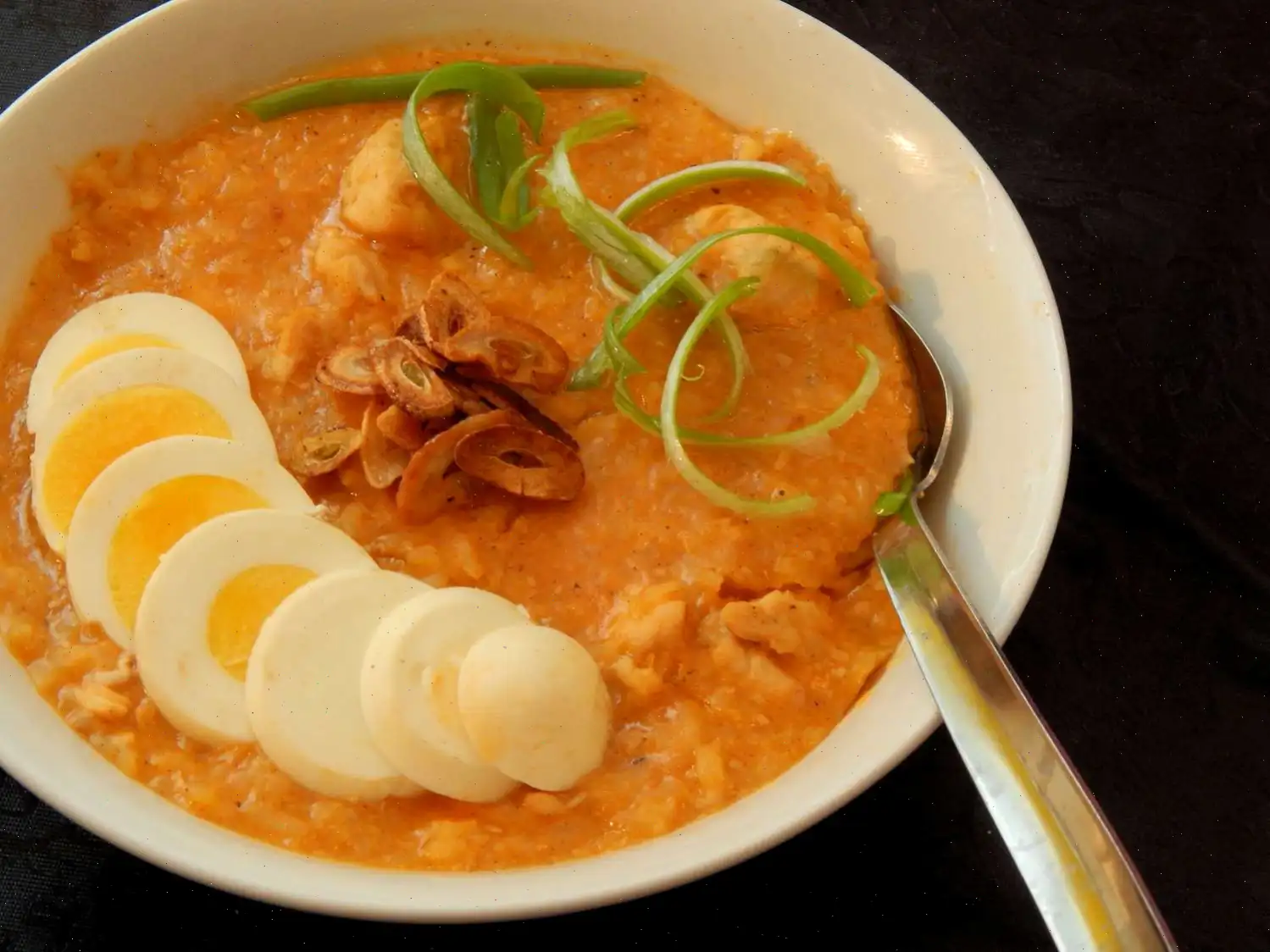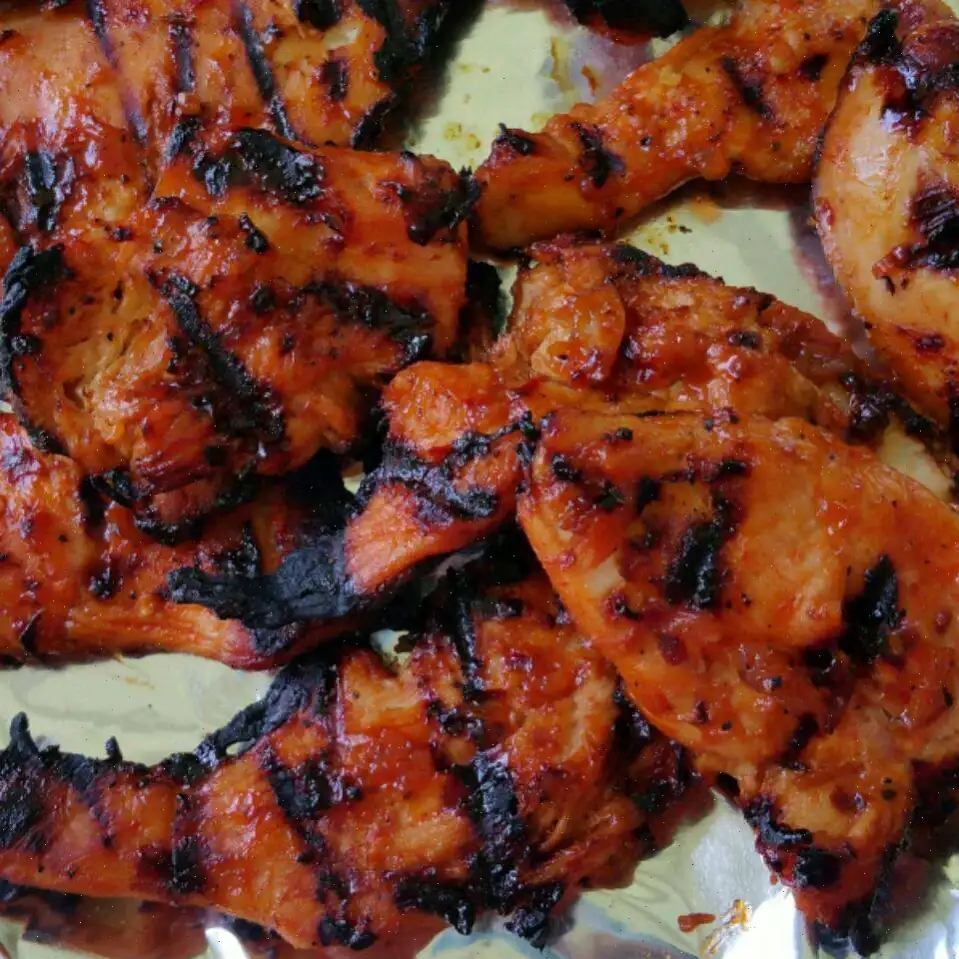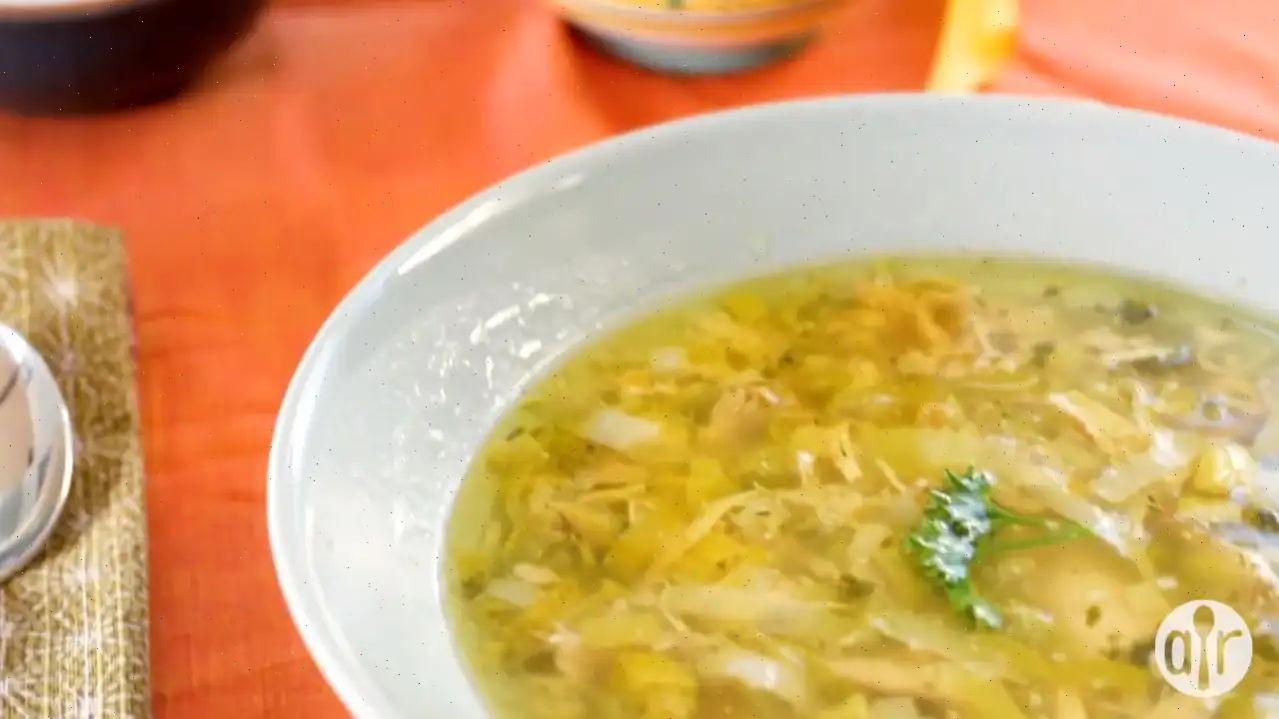
Filipino-Style Congee (Lugaw) Recipe
Ingredients:
- 5 cups water
- 2 cups uncooked white rice
- 3 tablespoons vegetable oil
- 1 whole head garlic, minced
- 1 tablespoon sliced ginger
- 2 tablespoons sliced onion
- 2 skinless, boneless chicken breasts, cut into cubes
- 1 tablespoon fish sauce, or to taste
- Ground black pepper, to taste
- 1 teaspoon annatto powder
- 2 hard-boiled eggs, peeled, or to taste
- 2 tablespoons chopped spring onions, or to taste
Directions:
- In a large pot, bring 5 cups of water and 2 cups of rice to a boil. Stir constantly and cook until the rice softens, about 25 minutes.
- While the rice is cooking, heat vegetable oil in a separate saucepan over medium heat. Add minced garlic and cook, stirring, until golden brown, about 5 minutes. Transfer half of the garlic to a small bowl and set aside.
- In the same saucepan with the remaining garlic, add sliced ginger. Cook and stir until fragrant, about 1 minute.
- Add the sliced onion to the saucepan and cook until softened, about 5 minutes.
- Next, add the cubed chicken to the saucepan, seasoning it with fish sauce and ground black pepper. Stir and cook until the chicken is no longer pink in the center, about 5 minutes.
- Stir the cooked chicken mixture into the pot with rice.
- Using a strainer, dust 1 teaspoon of annatto powder over the rice. Stir the mixture until the annatto powder dissolves into the rice.
- Add the hard-boiled eggs to the rice mixture.
- Reduce the heat and simmer, stirring constantly, until the rice reaches a porridge-like consistency, about 5 minutes.
- Remove the pot from the heat and stir in the chopped spring onions.
- Serve the congee in bowls, garnishing with the reserved fried garlic from earlier.
Nutrition Facts (per serving):
| Nutrient | Amount | % Daily Value* |
|---|---|---|
| Calories | 552 | - |
| Total Fat | 15g | 19% |
| Saturated Fat | 3g | 14% |
| Cholesterol | 135mg | 45% |
| Sodium | 348mg | 15% |
| Total Carbohydrates | 80g | 29% |
| Dietary Fiber | 2g | 6% |
| Total Sugars | 1g | - |
| Protein | 22g | 44% |
| Vitamin C | 6mg | 6% |
| Calcium | 84mg | 6% |
| Iron | 5mg | 28% |
| Potassium | 766mg | 16% |
* Percent Daily Values are based on a 2,000-calorie diet. Your daily values may be higher or lower depending on your calorie needs.

Origin and History of Lugaw
Lugaw, the Filipino version of congee, is a beloved dish that dates back to the pre-colonial period in the Philippines. It is believed to have originated as a simple, comforting rice porridge made from rice and water, commonly served to the sick or elderly. The introduction of various spices, meat, and flavorings over the centuries has made it a versatile and popular dish in Filipino cuisine.
While congee is found in many Asian cultures, the Filipino take on it stands out due to the addition of ingredients like fish sauce, ginger, garlic, and hard-boiled eggs, which contribute to its distinct savory and aromatic flavor profile. Over time, regional variations emerged, with different provinces adding their own unique twists to the dish.
Regional Variations of Lugaw
Lugaw is enjoyed across the Philippines, with each region putting its own spin on the classic dish. In the capital, Manila, its commonly served with chicken and a sprinkling of fried garlic. However, in other regions, it may be made with pork, beef, or even fish, depending on local availability and preferences. In the Visayas, it is often cooked with a richer broth and served with a boiled egg or sauted pork. On the other hand, in Mindanao, some variations include toppings like green onions and pickled ginger.
In some parts of the country, lugaw is paired with a tangy, vinegar-based dipping sauce to enhance its flavors. This dish is often eaten as a snack or breakfast and is known to be filling and comforting, especially during rainy days or cold evenings.
How Lugaw Differs from Similar Dishes
While lugaw is often compared to other Asian rice porridges like Chinese congee or Japanese okayu, it differs significantly in terms of ingredients and flavor profile. Chinese congee, for instance, is typically simpler and blander, serving as a base for various toppings like pickled vegetables, salted egg, or century egg. On the other hand, Filipino lugaw is rich in flavor due to the addition of ginger, garlic, fish sauce, and sometimes a touch of annatto powder for color.
In addition, unlike the thinner consistency of Chinese congee, Filipino lugaw tends to be slightly thicker, giving it a heartier texture. This makes it more satisfying and fulfilling, especially when served with protein-rich toppings like chicken or pork.
Where Lugaw is Typically Served
Lugaw can be found in various eateries and homes throughout the Philippines, from humble street food stalls to more formal restaurants. It is particularly popular as a street food dish and is often sold by vendors who set up shop in busy areas, offering quick, affordable meals for locals and tourists alike.
Aside from street food stalls, lugaw is also served in breakfast buffets, especially in hotels catering to Filipino and international guests. It is a staple in Filipino households, frequently cooked as a quick and comforting meal for breakfast or dinner. During festive occasions, some families prepare larger portions to feed guests or celebrate special moments.
Interesting Facts About Lugaw
1. The word "lugaw" itself comes from the Tagalog word "luto," which means "to cook." This reflects the simplicity of the dish, as it is essentially rice cooked in water until it becomes soft and porridge-like.
2. Traditionally, lugaw was considered a "food for the sick," as it is easy to digest and gentle on the stomach. It is still commonly prepared for those recovering from illness or for elderly family members.
3. The inclusion of annatto powder, which gives the dish a reddish hue, is a distinctly Filipino touch. Annatto is often used in Filipino cooking to add color and a mild, earthy flavor to dishes.
4. In some regions, lugaw is also enjoyed as a midnight snack, especially after a night of partying. Vendors often sell it late into the evening, offering a warm and savory dish that hits the spot after a long night.
FAQ about Filipino-Style Congee (Lugaw) Recipe
Comments
Elizabeth Clark
03/11/2023 08:49:30 PM
A wonderful and easy-to-make dish! It's delicious and comforting, perfect for those cold winter months in the east!
Ronald Diaz
08/08/2022 10:28:32 PM
I omitted the annatto powder when making this recipe. Although it took longer to prepare and used multiple dishes, I found that it lacked sufficient salt and needed a substantial increase in fish sauce. My rice ended up burnt, so next time I will lower the heat after it boils. Additionally, the recipe called for more water than the 5 cups stated; I ended up using around 15 cups and will likely use 20-23 cups next time as it evaporated quickly. Despite these adjustments, the flavor was decent, making it a good option for trying out a new cuisine.








